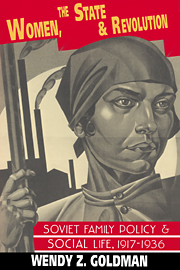Book contents
- Frontmatter
- Contents
- List of tables
- Acknowledgments
- 1 The origins of the Bolshevik vision: Love unfettered, women free
- 2 The first retreat: Besprizornost' and socialized child rearing
- 3 Law and life collide: Free union and the wage-earning population
- 4 Stirring the sea of peasant stagnation
- 5 Pruning the “bourgeois thicket”: Drafting a new Family Code
- 6 Sexual freedom or social chaos: The debate on the 1926 Code
- 7 Controlling reproduction: Women versus the state
- 8 Recasting the vision: The resurrection of the family
- Conclusion: Stalin's oxymorons: Socialist state, law, and family
- Index
- Soviet and East European Studies
4 - Stirring the sea of peasant stagnation
Published online by Cambridge University Press: 26 March 2010
- Frontmatter
- Contents
- List of tables
- Acknowledgments
- 1 The origins of the Bolshevik vision: Love unfettered, women free
- 2 The first retreat: Besprizornost' and socialized child rearing
- 3 Law and life collide: Free union and the wage-earning population
- 4 Stirring the sea of peasant stagnation
- 5 Pruning the “bourgeois thicket”: Drafting a new Family Code
- 6 Sexual freedom or social chaos: The debate on the 1926 Code
- 7 Controlling reproduction: Women versus the state
- 8 Recasting the vision: The resurrection of the family
- Conclusion: Stalin's oxymorons: Socialist state, law, and family
- Index
- Soviet and East European Studies
Summary
A chicken is not a bird and a baba is not a human being.
Traditional peasant proverbIt is necessary to say that a women's mind is exactly the same as a man's, that a baba is a human being.
Pichurina, peasant delegate to the All-Union Congress of Women Workers and Peasants, Moscow, 1927.In the late 1920s, the overwhelming majority (84%) of Russians were peasants, living within an agricultural system that was centuries old. One historian observed that it was not unusual to see a peasant or even his wife dragging a wooden plough “dating back to the time of the flood” across the fields. Four of five Russians lived in villages; three of four employed people worked in agriculture. Urban life was concentrated in small industrialized islands around Moscow, Leningrad, the Urals, and parts of the Ukraine and Azerbaidjan. In the great majority of provinces, 85% to 95% of the people lived in the countryside. People lived in tiny, isolated hamlets with an average size of 200 people, thirty to forty households. And most of these settlements, in the words of the rural historian V. P. Danilov, “were truly God-forsaken places.”
The Revolution had done little to improve the productive basis of agriculture, and in many ways it had actually undermined it. In redistributing the gentry's estates, the peasants eliminated large holdings and revived many age-old features of peasant life, like the village commune. Peasants still relied mainly on manual labor with primitive tools. Few owned machines and most survived with minimal dependence on the market. Only a tiny fraction of the rural population was employed in factories (1.1%) or cottage industry (1.6%).
- Type
- Chapter
- Information
- Women, the State and RevolutionSoviet Family Policy and Social Life, 1917–1936, pp. 144 - 184Publisher: Cambridge University PressPrint publication year: 1993



